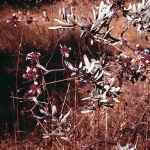| Common Name: |
Yerba Santa |
| Other Names: |
Bear's Weed, Gum Leaves, Tar Weed, Mountain Balm, Wild Balsam |
| Botanical Name: |
Eriodictyon californicum |
| Genus: |
Eriodictyon |
| Family: |
Hydrophyllaceae |
| Cultivation: |
Sandy, gravelly, or rocky soil in dry, sunny conditions. Thrives on slopes in full sun. If required, trip to shape in spring or summer, cutting into new or one-year-old wood only. |
| Propagation: |
By seed sown in spring or autumn; by semi-ripe cuttings of side shoots in summer. |
| Harvest: |
Leaves are picked in late spring; used fresh or dried for infusions and liquid extracts. |
| Native Location: |
California and Oregon |
| Height: |
2.5m (8ft) |
| Width: |
2m (6ft) |
| Hardiness: |
Min. 5-7°C (41-45°F) |
| Parts Used: |
Leaves |
| Chemical Constituents: |
Formic acid
Pentatriacontane eriodictyol
Resin
Tannic acid
Tannins
|
| Properties: |
An aromatic, pleasant-tasting, tonic herb that reduces spasms, expels phlegm, and lowers fever. |
| Known Effects: |
Masks taste of bitter medicines
Decreases thickness and increases fluidity of mucus in lungs and bronchial tubes
Interferes with absorption of iron and other minerals when taken internally
|
| Possible Additional Effects: |
May treat hay fever and other nasal allergies
May treat hemorrhoids
|
| Warnings and Precautions: |
Don't take if you:
Are pregnant or think you may be pregnant or plan pregnancy in the near future
Have any chronic disease of the gastrointestinal tract, such as stomach or duodenal ulcers, reflux esophagitis, ulcerative colitis, spastic colitis, diverticulosis, or diverticulitis
Consult your doctor if you:
Take this herb for any medical problem that doesn't improve in 2 weeks (There may be safer, more effective treatments.)
Take any medicinal drugs or herbs including aspirin, laxatives, cold and cough remedies, antacids, vitamins, minerals, amino acids, supplements, other prescription or nonprescription drugs
Pregnancy:
Dangers outweigh any possible benefits. Don't use.
Breastfeeding:
Dangers outweigh any possible benefits. Don't use.
Infants and children:
Treating infants and children under 2 with any herbal preparation is hazardous.
Others:
None are expected if you are beyond childhood, under 45, not pregnant, basically healthy, take it only for a short time and do not exceed manufacturer's recommended dose.
Storage:
Store in cool, dry area away from direct light, but don't freeze.
Store safely out of reach of children.
Don't store in bathroom medicine cabinet. Heat and moisture may change the action of the herb.
Safe Dosage:
Consult your doctor for the appropriate dose for your condition.
|
| Adverse Reactions, Side Effects or Overdose Symptoms: |
| Signs and Symptoms |
What to do |
|
| Diarrhea |
Discontinue. Call doctor immediately. |
| Nausea or vomiting |
Discontinue. Call doctor immediately. |
| Medicinal Uses: |
Internally for asthma, bronchitis, laryngitis, sinusitis, and hay fever. An ingredient in over-the-counther cough mixtures; added to better medicines to improve the taste. Smoked by native N Americans for asthma and chewed for mouth hygiene. |
| Culinary Uses: |
Fresh or dried leaves make an aromatic, sweet, pleasant-tasting tea. |
| Economic Uses: |
Leaf extract is used to flavor baked goods, candy, ice cream, and soft drinks. |
| Bibliography: |
Encyclopedia of Herbs by Deni Brown. Copyright © 1995, 2001 Dorling Kindersley Limited. pg 204
Vitamins, Herbs, Minerals & Supplements, The Complete Guide by H. Winter Griffith, MD Copyright©1998 Fisher Books pp.474-475
|
|

